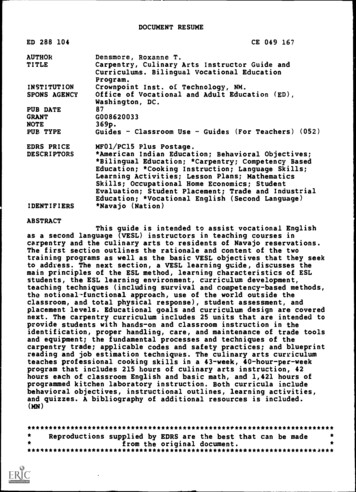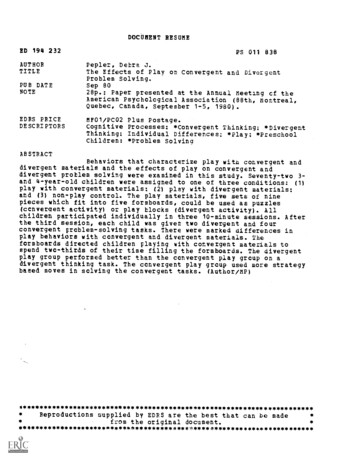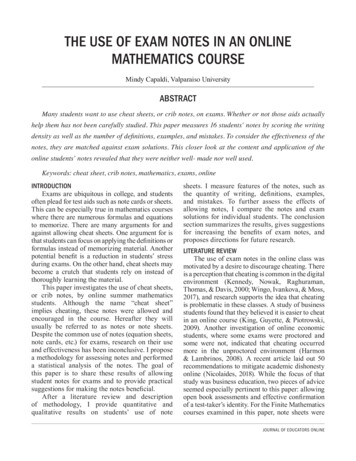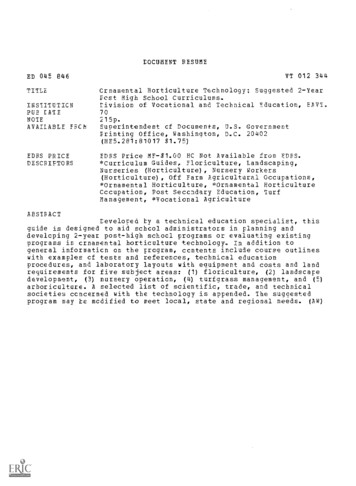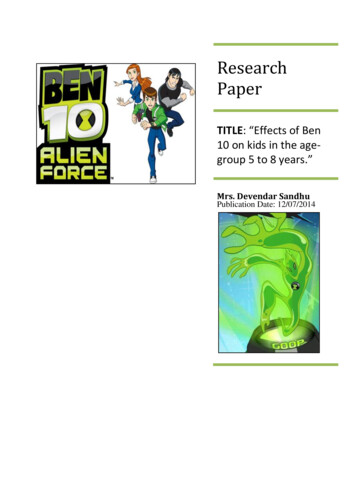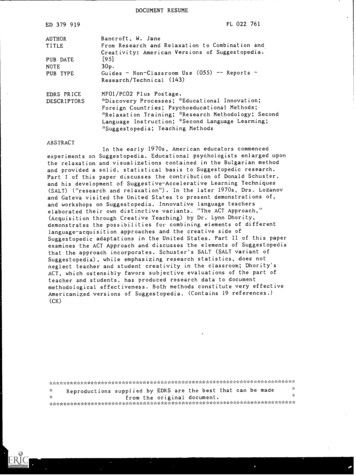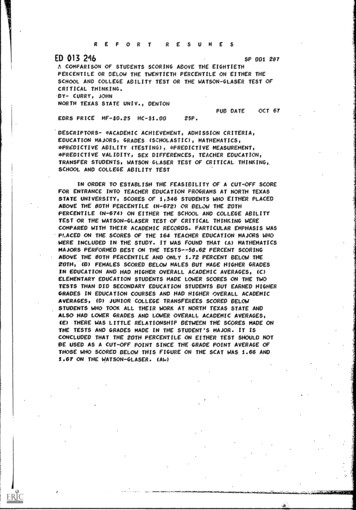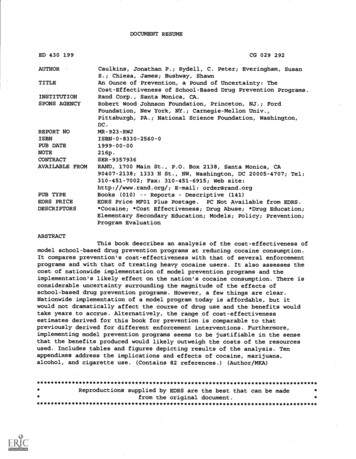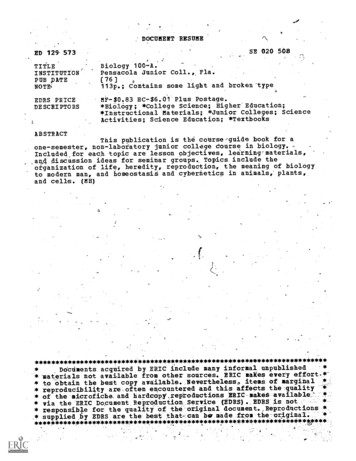
Transcription
.0#DOCUMENT 'RESIINESE 020 508ED 129- 573Biology 100-A.Pensacola Junior Coll., Fla.0[76]113p.; Contains some light and broken typeTITLEINSTITUTION'PUB pATENOTE%,.MF- 0.63 HC- 6.01 Plus Postage.*BiolOgy; *College Science; Higher Education;*Instructional Materials; *Junior Colleges; ScienceActivities; Science Education; *TextbooksEDRS PRICEDESCRIPTORSABSTRACTThis publication is the coUrse-guide book for aone-semester, non-laboiatory junior college course in biology. Included.for each topic are lesson objectives, leirning-materials,a44 discussion ideas for seminar groups. Topics include theotganization of life, heredity, reproduction, the meaning of biologyto modern man, and homeostasig and cybernetics in animals, plants,and cells. ***************************Doctiments acquired by ERIC include many informal unpublishedERICmakeseveryeffort,*"* mat-erials not available from other sources.* to-obtain the best copy available. Nevertheless, items of marginal ** reproducibility are.often encountered and this affects the quality* of the microfiche and hardcopy,regroductions ERIC maket available:** via the ERIC Document ReProduction Servite (EDRS). EDRS is not* responsible for the quality of the original document.,Reprodnctions *** supplied Ly BIDES are the best that-can be made from the ******************************,
TABLE OF CONTENTSPAGEUNITTINTRODUCTION.1.'89-esIUNIT II'HOW UNIQUE IS LIvoG MATTER?UNIT III.A "MODEL" FOR LIFEUNIT IV,THE.D.RGANIZATIQN OF LIFE. PART Isss51s1711111.27PART Ilee1'140A.UNIT VTHE ORGANIZATION OF LIFE.;9.,10eUNIT VI.THE CONCEPT OF APPROPRIATE SIZEUNIT VIIWHAT DO WE INHERIT?eUNIT VIIIHow LIKE BEGETS LIKE1.U;IIT'IX.SCIENCE; SExese1MORE ABOUT OTHER THINGSsUNIT XICHANGESS55Ie11S1S1,1I.ANDOTHER THINGS,UNIT X.e1e'eSe11.314UNIT XIITERRESTRIALIZATIONIUNIT XIIIHOMEOSTASIS AND CYBERNETICS IN ANIMALS,e1UNIT XIV .HOMEOSTAStS.AND CYBERNETICS.IN PLANTS AND%II.1CELLS 11.'S"11/.tJNITXVTHE MEANING OF BIOLOGY TO.MODERN. MAN,eeO99
BIOLOGY 100-A-UNIT ISiINTRODUCTION
OBJECTIVES FOR UNIT IINTRODUCTIONTO DEMONSTRATE THE CONCEPT OF "INDEPENDENT SYUDY" AS ACOMPONENT-OF THIS COURSE.2.TO INTRODUCE THE KIND'S OF LEARNING RESOURCE MATERIALS THATWILLBE UTILIZED IN THIS.COURSEi'I.TO BEGIN A SERItS1DV EXitRIENCES WHICH HOPEULLY WILLLEAD YOU TO BECOME MORE BIOLOGICALLY AWARE THAN PERHAPSYOU ARE AT .THIS POINT.TO BECOME FAMILIAR WITH THE COMPOUND LIGHT MICROSCOPE;ITS. WORKING PARTS AND PROCEEDURES FOR USE.5.DEMONSTRATE COMPETENCE IN THE 6SE OF,THE MICROSCOPEBY LOCATING AND IDENTIFYING PARTS OFA TYPICAL PLANT.CELLATeI
TOPICS FOR.DISCUSSION.IN SEMINa GROUPSIN RELATINSHIP TO'THE EDUCATIONAL PROGRAM O MAOR THATYOU ARE PURSUING., WHAT SIGNIFICANCE DO YOU SEE bENERAL. BIQLOGY" HAVING?:-.WHAT SIGNIFICANCg DID THE INVENTION OF THE'LIGHT MICROSCOPEHAVE FOR ildIOLOGYY. HOW WOULD YOU EXPECT-PRESENT,DAYTECHNOLOGY TO INFLUENCE BIOLOGY?4.3. 'THE PURPOSg OF THIS SEGMENT OF YOUR COURSE 1 TO GET YQUTO TALK. 'DISCUSS AND SUGGEST WAYS WLTH.YOUR INSTRUCTOR.TO MAKE THE THIRTY MINuEs MORE.FRODUCTIVE AND MEANINGFUL'TO YOU AS A STUDENT. AKEMEMBER THAT THE'LAF THIRTYMINUTES.OF THIS PERIOD IS FOR A WEEKLY QUIZ).EUKARYOTIC CELLpinocytosis channelcMurilpinosomesplasma eus nucleolub'chromosomegranular reticulum4mitochondrion
\EyepieceBody Tube-NosepieceCm rse Focus.,--objectivesStage ClipIStageFine FocusIris Diaphragm.Plano-concave .Mirror.9Inclination JointBaseParts of the Compound Microscope.9
BIOLOGY 160 AIn,UNIT IIHow UNIout IS LIVING MATTER?0,
OBJECTIVES FOR.UNIT IIHow UNIQUE IS LIVING MeTEROPON COWLETION OF UNIT II THE STUDENT SHOULD BE ABLE TO DOTHE FOLLOWING:,JEFINE,"SCIENCE" AS IT'AELATES TO SUPERNATURAL VS.NATURAL LAWS.- .FXpLAINWHAT AS MEAT BY THE PHRASETHE PARTICLES3.THL.LANS ANp.AS IT RELATES TO LIVING,MATTER.WAKE THREE CHARACTE5ISTfCS,WHICH IDENTIFY ANYTHINGTHAT CAN' BE TERMEDLIVING!.4.,DEFINE METABOLISM,5:CIST FOUR CHARACTERISTICS OF MACROMOLECULEt WHICH ENABLETHEM TO 1E CLASSIFIED As ZONSTITUTING A LIVING SYSTEM.6.EXPLAIN.BEHAVIORAL CHARACTERISTItS OF ATOMS ARELARGELY DETERMINED BY-THE OUTER SHELL ELECTRONS.718.'DIFFERENTIATE BETWEEN AN,ATOM AND AN ION,.DISCUSS THE'TWO METHODS 14HEREBY CHEMICAL BONDS CANBE FORMEIIBETWEEN ATOMS,0 FTHE TWO METHODS WHICH IS,MORE CHARACTERISTIe0F.BONDING OCCURRING IN LIVING MATTER?10.BE ABLE TO GIVE Ap\fE4SON FOR THE sELECTIoN OF YOURANSWER IN #9 ABOVE ,LIST 4 ATOMS WHICH GONSTITUTE APPROXIMATELY 99% OF, - LIVING MATTER.11.aGIVE TW9 REASONS WHy THE FOUR ATOMS ABOVE ARE DISTINCTLY"FITTED FOR THEIR 'ROLES" IN LIVING MATTER;13,EXPLAIN WHY THE STATEMENT THAT "CARBON IS THE MOST.FIT AMONG THEELEOENTS TO.SERVE AS THE OOLECULAR BACKBONE(STRUCTURAL BASIS OF ALL LIVING MATTER IS TRUEo14.SIVE REASONS' WHY WATER IS SO IJNIQUELY PITTED. TO SERVE-A,,ROLE IN BIOLOGICAL SYSTEMS THAT NO OTHER MOLECULE COULDTAKE ITS RLACE.15;DIFINGUISH BETWEEN ACIDS AND BASES; WHAT GIVES EACii,S SPECIFIC PROPERTIES, wHAT IS THE,CONCEPT OF P:("7"
TOPICS FOR DISCUSSION AN SEMINAR GROUPS1.TWO COTRASTING VIM4POINTS OF LIFE/TOPERATIONAL PROCEEDURES.IHE ULTIMAT@ AIM OF BIOLOGY IS-TO EXPLAIN LIFE IN(A)TERMS OF PHYSICSNAND CHEMISTRY.LIFE PROCESSE.S4GOVERNED BY A SUPERNATURAL BEING OR(B)FORCE.45 A,,LIVINGFORM .UNIQUE, WHEN COMPART) TO A NON-LIVINGWBSTANTIATE YOUR AN !SWER. 1,FORM,-WHAT IS YOUROPINION OF THE STAT-EMENT "RESEARCH ON THE:CHARACTERISTICS OF THE ATOMS' AND MOLECULES TOUND INLIVING MATTER HAS Lui TO 'THE 'CONCLUSION TAT LIFE ANYWnERE:MOST PROBABLY.IS DESIpED ON A PATTgRN SIMILAR.TO THATFOUND 0. THIS PLANET. ,(i .E., AlIC711-U, WATER SCHEME)'-4.Da'you 'CONSIDER.MANTO" B'.E THE MOtT ".UNI6UE" FORM ON-EARTH.'DEFEND.YOUP ANSWER.'-.ei.;.
6PNIT IIThe elements necessary for Life Comparing theirTable I.Relative Abundance in the Universe, Earth's Crust, and the Human(Loewy and Siekevitz, Cell Structure Function,. p. eAbundance (%)Chemical AtomicEarth's Crust-Human a2.61.80.230.12,.0.70.01-0.13 .,0.130.0330.037?1.41.9,-' 0.22,.Ultratrace .0.0260.0nA9121.2,.,*2526272930420.047.0.00059l .9:.'1,The bioelemants (those fOund in living life forms). fall intothree groups according to'tIlleii occurence in living organisms,the thajor constitueniS accounting for about 99% of all.elethentsfound in living organisms, the trace dlements - required by allorganisms but in much lesser quantities,'and thd ultratrace elements .many of 'which are not of universal occUrence. Note that therelative abundances- - occurrence in the universe, earth's curSt;and the human body - do not show a general correla4on.Life and the ieriódic TableA characteri istc property of living matter is that it isselective. It selects certain environments; it utilizes only.,-certain molecules as food sources; it aggregates.in particularorganizations. An example of this selectivity is he preferencessiblefor only certain elements from thelarge lements.O' d'P1 2',%e-
carbon and,nitrogen with the remaining elements constituting lessthan one percent of the total (Table 1). From this, one canconclude that living matter preferentially.selects for certainelements which are made available to it in the earth's crust andatmosphere.To more fully appreciate this selectivity, a-bit of bibkground information may be, desirable on-the natu*e of chemicalelemenii. It is an interesting-property of the elements that .they can be organized into a ceitain pattern and everywhere,the elements conform to this classificationc-,N sound and.usefulclassification of the elementse basea on the atomic structure of(See Table II).eackeleumlt,isfoundinablEi.7.
Inasmuch as our'objective is-to understand the natural lawsinvolved in the interactions between certain atoms to form moleculewe need concern ourselves onlY with the outer portion of the atoms,A fundamental premise in atomic theory is that thethe electrons.chemical behavior of the atoms is a function of their peripheral(outermost) electrons only. The -'eriodic Chart is more understandable if we ignore the insides of , .e atom and censider the acitionsof the electrons'in the outer'region.In the Periodic Table, all known eleMents are grouped accordinc'to chemical properties', that is those with similar chethicalproperties occur again and again with regular periodicity, henceElements with similar properties atethe name, Periodic Table,represented by the vertical columns of elements. For example,all of the elements in the column under hydrogen (chemiCalsymbol H) have one outermost electron and diSplay therefore, certa'icommon properties. All elements listed under beryllium (Be) havetw6 outermost'electrons and show characteristics in'common whichare.different from Group I. For each element, the atomic numberis given above the symbol forhthe element: The atomic numberdescribes the number of protons (plus charges in the atom, seeFigure 1) in the atom and is always eqpal to the'number of electrorin that atom. ;Hence carbon, atomic number 6 has six (6) protons(6 ) and six (6) electrons (6-). In moving from left to rightacross the chart, the ,efements are arranged in increasing.orderThe extreme right handof protons, (hence, also electrons).column (v111) are located the Noble gases, the chemically "desired'Thus, chemically carbon,. At. estate of .each element,in that row.No. 6 would ,like to "look like" Neon (Ne) At No. 10.
.EleCtron(negativecharge)NeutronProton(positive on.NitrogenOxygenFig. 1 Neutrons, protons and electrons in theconfigurations of atoms.Circle the majorCompare the Periodic Table !with Table I.and trace elements (from Table I) in the Periodic Table'to empasize'their position in the Table. It is readily apparent that theelements found in living organisms tend to be the lighest elements. That ).n itself does not seem strange, for the lightest,elements tend also to be the most abundant, on earth as elsewherein the universe. However, when one compares the occurrence ofthe first three elements in the human body with their relative.numbers on the earth-7it-is-readily-apparent that an arguMentfrom abundance is notthe whole answer - for organisms can concentrate many times over these relatively rare elements. A study.of Table I, comparing the incidence of the'bioelements in the uniiverse with their ocCurrence,-on this planet and in the human body,leads to the conclusion that these elements were selected for bybnature on the basis of their essential properties rather than theiravailability. It is remarkable in this respect that living matteris, very much like-the cosmos as a whole. ,The stars as-well-asthe interstellar matter are composed mostly of lightelements.Our earth is but a "mineral ash" of heavy elements that remainedafter the light ,elements disappeared into space owing to the weakgravitational pull of tiny earth.HOW MUCH ARE YOU WORTH?A,'Nothing escapes the.inexorible spiral of inflation.It stands 'to reason that the chemicals in the hUm*n.body muSi-be worth more with each passingryear.At present, ths approximate value of ailchemicalsin the average adult.human body is 1.504-reportSDonald.2,-. Forman, assistant prof.'of. biOchemistry.
Northwestern University Medical School, and head ofthe chemical laboratory, at the Northwestern-affiliatedThis new evaluation representsEvanston hospital.a 257% increase over the 1936 estimated value forthe same chemicals of 980.In percentage terms, Forman says tile adult bodyis composed of 65% oxygen, 18%.carbon, 10% hydrogen,3% nitrogen,. 1 1/2% calcium, 1% phosphorous and 1 1/2%of other elements, including traces of gold andsilver.*******a * *1.16** ***********
Review of Atmic Structure.(If more information is required,consult a textbook, i. e., Biology,-H. Curtis, pp. 94ff)(Fill ,in the'blanks as directed.Answers are given in Appendix I)According to current concepts, all matter in the physicaluniverse is composed of particles. Although approximately 36different po.rticles have been identified bY physicists, three areparticularly important to biological systems. These are neutrons,protons and electrons. The particles can be arranged'into unitscalled atoms. There are 104 diffP7-Ant kinds of atoms presentlyknown. -Eaas different kind of atom is called an element. Henceelements known today.there are1.These 104 elements differ in the organization of their 3 basicOne model of atomicparticles: protons, neutrons and electrons.structure places protons.and neutrons in the nucleus of the atomwhile,electrons are found in shells (or orbits) at varying distancesfrom the nucleus. Any two elements are different in the organiz2-,ation of their2.Protons and neutrons both have weight. Each proton.- and each3.neutron is arbitrarily given an atomic mass unit (a.m.u.) of oneThe combined weight of all protons and neutrons in an element(1).is the at6mic weight of that element. The number of protons ina nucleus gives the atomic number of that element. On the linesbelow indicate-the atomic weight'and atomic number given theinformation to the left.,Atomic Weight(a.m.u)A.6 protons',6 neutronsB.5 protons,6 neutronsAtomic Number.:0.'11-protons, 12 neutronsD.A0 protons, 35 neutrons'Neutrons do,not contribute to-the chemical properties of an'element. However, they'do play a role in general stability ofthe atom. The number o&neutrons in a nucleus may vary. Theatomic weight, given as a fraction
inclination joint. base . plano-concave. . parts of the compound microscope. 9. biology 160 a. i. n, unit ii. how uniout is living matter?, 0. objectives for.unit ii how unique is living meter. opon cowletion of unit ii the student should be able to do the following: jefine,"science" as it'aelates to supernatural vs., natural laws.- -. . xplain what as meat by the phrase. f. thl. lans anp .
